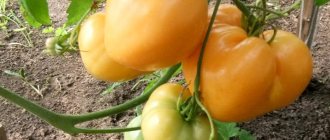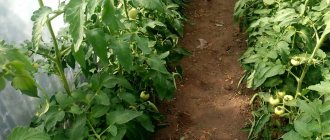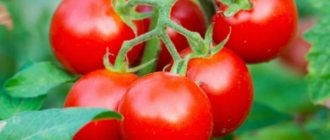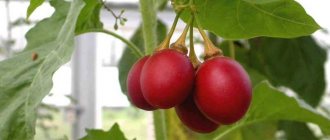Home / Vegetable garden / Tomatoes
Back
Published: 11/02/2020
Reading time: 20 min
4
Domestic breeders are constantly working to develop unpretentious and early tomatoes that can produce crops in short and cool summer conditions. Low-growing Sanka tomatoes have proven themselves well in the middle zone, the North-West, Siberia, and the Urals. The unpretentious tomato will delight you with its harvest already in June, and even though its taste is not for everyone, gardeners willingly grow “Sanka” in beds, in greenhouses and tunnels.
- 1 Description of the variety
- 2 Characteristics of fruits 2.1 What summer residents say
- 5.1 Subtleties of cultivation
How did the variety appear?
The Sanka tomato variety is the brainchild of breeder Yuri Ivanovich Pantchev. In 2003 it was included in the State Register of the Russian Federation. Experts recommend growing it in the regions of the Central Black Earth region. The tomato bears fruit well in the beds of the Voronezh, Tambov, Lipetsk, Oryol, Kursk and Belgorod regions.
However, gardeners in other regions grow it on their plots, including in greenhouses and greenhouses, and receive an excellent harvest. And in areas with a warm climate, the crop is harvested 2 times per season.
Productivity of the variety
We recommend reading our other articles
- Late Moscow cabbage variety
- Melon planting
- White radish
- Corn calories
The productivity of the Sanka tomato is average and not all gardeners like it. However, it is very often grown together with other, more productive varieties. The reason why they choose it is its unpretentiousness and unsurpassed taste! Maturation is usually amicable. Once the tomatoes are ripe, you can begin to harvest. With normal care, up to 15 kg of crop is harvested per square meter - this is about 4 kg from a bush.
Important!
Due to the presence of a dense peel, Sanka tomatoes do not crack when canned as a whole.
This variety of tomatoes is stored well in the refrigerator. They are eagerly bought at the market. Universal use, suitable for canning, making juice, dressing for borscht. If you want to plant the variety again next year, you can take a couple of the most beautiful tomatoes and collect seeds from them. Since this is not a hybrid, they will be an ideal planting material, the main thing is to collect them from healthy crops.
Photo of Sanka tomato harvest
Botanical description
This tomato belongs to the determinate species, that is, it is a representative of low-growing tomatoes. The height of the bush varies from 40 to 60 cm.
The stem is strong, so the plant does not need additional support. The leaves are medium sized and green in color. The first inflorescence is laid above the 7th leaf, the subsequent ones - after 1-2 leaves. This intermediate arrangement of inflorescences allows you to avoid pinching, but you shouldn’t let the development of the plant take its course either. Sometimes it may still be necessary to remove excess shoots. The brush is simple.
The fruits are formed early, but the timing of ripening is influenced by climatic conditions and the growing region. The first harvest is harvested on average after 80 days.
The tomatoes are round, slightly ribbed. The weight depends on the place of cultivation. In closed ground, the weight of one tomato can reach up to 100 g; in open ground, the weight is much more modest, and on average does not exceed 80 g. The ripe fruit has a rich red color, while the unripe fruit is green. The flesh is fleshy and dense.
Growing rules
The requirements for growing Sanka tomatoes are standard. It is customary to plant seeds indoors in seedling boxes; as the weather warms up, the tomatoes are transferred to a greenhouse or garden beds.
Planting seedlings
To plant Sanka seeds in a greenhouse, it is customary to sow Sanka seeds in early March; for open ground, it is better to wait until the middle of the month.
To grow seedlings, you need to prepare a long box and fill it with fertile, loose soil with the addition of humus and sand.
The mixed soil is spilled with potassium permanganate, then a complex mineral mixture is added. Meanwhile, the seeds are soaked for a day in water with a growth stimulator.
The seeds of the Sanka variety are planted shallowly in the soil - only 2 mm, while 4-5 cm are left between individual seeds. The seeds are carefully watered, and the box is covered with film and placed in a warm place.
After about 5 days, seedlings will appear, at which point the box will need to be placed on a lighted windowsill and focus on watering so that the soil is constantly slightly moistened.
Tomato seedlings are transferred to the ground in mid-May or by the end of the month
A couple of weeks after germination, the tomato can be fed with urea and then fertilized in the same way - at intervals of a couple of weeks. When the sprouts have 2 true leaves, they can be picked.
Important! 2 weeks before planting in a greenhouse or soil, seedlings begin to harden. To do this, they are taken out into the fresh air every day and left outside for some time, gradually increasing the duration.
Transfer
The Sanka variety is transferred to closed greenhouses approximately 60 days after sowing the seeds, and to open ground after the final establishment of warm weather in May.
The area for tomatoes should be well-lit, not swampy, with loose soil. To plant seedlings in a greenhouse or garden bed, prepare small holes no more than 10 cm deep.
Sanka is planted in rows, 4 bushes per square, with a distance of about 50 cm between individual plants; before planting, the soil and seedlings are properly watered.
You need to water the tomato again immediately after planting. Then it is best to temporarily cover the tomatoes with light non-woven material, so the variety will quickly take root in the new place.
When growing, it is important not to forget about watering tomatoes.
Aftercare
Caring for a Sanka tomato is quite simple and consists of several procedures:
- Watering. Tomatoes do not like excess moisture, but they also do not tolerate drought well. Therefore, the soil should always be slightly moist. Watering should be carried out especially frequently during the formation of flower clusters and when the fruits ripen.
- Feeding. Tomato Sanka is usually fertilized three times. First, 2 weeks after transfer, nitrogen fertilizing is applied to the beds, when planting inflorescences, phosphorus-potassium fertilizers are added, and after the ovaries are formed, potassium is added again.
- Loosening. Since the root system of the variety must be well ventilated, the soil must be loosened weekly. At the same time, this helps to get rid of weeds that take away the strength of the tomato.
There is no need to tie up or pinion the Sanka variety. But at the same time, it is recommended to mulch the ground under the bushes with a layer of straw.
Characteristics
The table below shows the main characteristics of the tomato:
| Characteristic | Variety indicators |
| Type of bush | determinant, standard |
| Ripening period | ultra-early, 75-85 days |
| Productivity | 12-14 kg/sq. m, from one bush - 2-3 kg of fruits |
| Number of fruits per cluster | 4-5 fruits |
| Fruit weight | 90-100 g |
| Form | rounded, slightly ribbed |
| Fruit color | red |
| Skin | not prone to cracking |
| Transportability, keeping quality | tall, can withstand long-term transportation without loss of presentation |
| Purpose | fruits are suitable for fresh consumption, whole-fruit canning |
| Disease resistance | high immunity to diseases, fruits ripen before late blight appears |
Fruit characteristics
- The tomatoes are small, round, smooth and beautiful. They have a bright red color and ripen at the same time, which facilitates the collection procedure.
- The fruits weigh generally 100-150 g.
- The skin is dense. Tomatoes can be picked unripe. They ripen perfectly outside the bush without losing their appearance and taste.
- The pulp is dense, not watery, unlike other early varieties, aromatic and pleasant to the taste.
- The dry matter content is 4-5%.
Important! The seeds can be used to propagate the variety.
Advantages and disadvantages of the variety
Why did gardeners like this variety so much? Vegetable growers who grow Sanka have the following advantages:
- its early ripeness;
- cold resistance;
- undemanding to light - fruits ripen with a small amount of light;
- it can be grown both in open and closed ground;
- high immunity to diseases and pests;
- good fruit set under unfavorable weather conditions;
- friendly harvest formation;
- seed material can be collected independently.
However, it also has its downside - the average yield.
See the Sanka tomato review below:
Tomatoes Sanka on video
If you grew early-ripening Sanka tomatoes, please write in the comments whether you liked them or not. What was the yield and taste of the fruits in your climatic conditions? Will you grow them again? How do you rate the disease resistance of this tomato variety? Briefly describe the advantages and disadvantages of this tomato in your opinion. If possible, attach a photo of the entire bush or individual fruits you grew to your comment. Thank you!
Your reviews of the Sanka tomato and additions to the description will help many gardeners evaluate this variety more objectively and decide whether it is worth planting or not.
You can order seeds from our collectors now. Catalogs have been updated.
Growing seedlings
When to sow seeds for seedlings depends on where the tomato will grow in a permanent place. Thus, seedlings are planted in open ground in the Central Black Earth region in early April, and they are transplanted into a greenhouse earlier - in the middle or end of March. The optimal age of bushes for transplanting to a permanent place is 60 days.
Thus, the seeds are sown in containers at the end of January-February. In areas with cooler climates, seed sowing dates are delayed by several weeks.
Seeds collected independently must be prepared before planting. First, they are soaked in a slightly pink solution of potassium permanganate for disinfection. All floating specimens are drained because they will not germinate. Then they are washed in running water and soaked - filled halfway with warm water. The water is changed 3 times a day. The hatched seeds are sown in the soil.
If purchased seeds are used, they are sown dry, since the manufacturer usually processes all seed material before packaging.
The soil for growing seedlings can be purchased ready-made or prepared independently from the following components, taken in equal parts:
- turf;
- sand;
- peat
The seeds are laid out in rows, the distance between them is kept 1 cm. They are buried into the soil to a maximum of 2 cm. For germination, it is necessary to maintain a temperature of +25°C, and the box is well covered with plastic film to create high humidity. As soon as the first shoots appear, the film is removed.
Caring for seedlings is no different from other crops. Plants need light (at least 8 hours) and watering - the soil should not dry out, but excess water is contraindicated. In the phase of two true leaves, they are picked into separate containers. Seedlings are planted in a permanent location when the bush has 6-7 leaves and at least one flower cluster.
Characteristics of the variety
The variety was registered in the State Register in 2003. Seeds are produced and sold by many well-known agricultural companies, SeDeK, Siberian Garden and others). For summer residents, this tomato is convenient because its seeds, collected from their plants, are quite suitable for sowing in the next gardening seasons. (Seeds of hybrid varieties must be purchased every season.)
In the photo - packages with Sanka tomato seeds from various manufacturers
Plants are determinate, low-growing. In open ground they grow up to 60-70 cm, but in a greenhouse they can reach a height of 100-110 cm. The stems are not very strong, droop and break under the weight of the fruit. Therefore, bushes are usually tied to supports.
Russian gardeners practice two approaches to the formation of tomato bushes:
- growing with pinching. All side shoots located below the first flower cluster are removed, and the remaining “stepchildren” are allowed to grow and form a crop;
- cultivation without pinching. All side shoots are left on the plant. The bush turns out to be spreading. A tie-down to several supports is required so that the filling fruits do not come into contact with the ground.
In both cases, seedlings are planted in a permanent place at the age of at least 60 days, placing from 4 to 6 plants per square meter of bed.
The stems of the plant are not very strong; they droop and break under the weight of the fruit. Therefore, bushes are usually tied to supports
The “Sanka” tomato is an early ripening variety: the first ripe tomatoes can be harvested already 75-80 days after the appearance of full shoots. The fruits are fleshy, red, round in shape. Tomatoes are great for home canning: they are smooth, almost equal in weight (from 70 to 90 g), and have a dense skin that is not damaged when poured with hot marinade.
The productivity of the variety is assessed as very high. With timely application of fertilizing and regular watering, up to 2.5 kg of fruit can be collected from each plant (some summer residents report yields of up to 4 kg per bush). In farms of the Central Black Earth region, the variety is successfully used for mass production of early soil products.
Regarding the taste, the opinions of summer residents differ greatly. Some evaluate them as quite worthy, others note a distinct sourness, and claim that tomatoes of this variety are seriously inferior in taste and aroma to other salad varieties (especially large-fruited varieties of raspberry and pink coloring). Of course, there is a significant amount of subjectivity in assessments of this kind. We should not forget that “Sanka” fruits grow well and bear fruit in areas located in “risky farming” zones, where not everyone succeeds in cultivating more “capricious” varieties.
“Sanka” belongs to the early ripening varieties: the first ripe tomatoes can be harvested already 75-80 days after the appearance of full shoots
It is worth listing the advantages that make this variety attractive to Russian vegetable growers:
- early ripening period, allowing harvesting before the height of late blight;
- unpretentiousness of plants, good fruit set in difficult weather conditions;
- friendly filling and ripening of fruits;
- consistently high productivity;
- resistance to major tomato diseases;
- versatility of fruit use.
The variety can be cultivated in “extended cultivation”, growing on each bush not only the earliest, but also an additional late harvest (provided that work is carried out to protect plants from late blight).
Some summer residents note another interesting property of Sanka tomatoes, which speaks in favor of the variety. When grown without pinching, the bushes continue to form flower clusters and “feed” fruits after the first wave of harvest has been produced. This phenomenon is observed both in open ground in regions with warm summers, and in areas with a less comfortable climate, when cultivated in greenhouses (of course, subject to measures to protect plants from late blight). It turns out that the variety can be cultivated in “extended cultivation”, growing on each bush not only the earliest, but also an additional late harvest.
In large farms, the variety is successfully used for mass production of early soil products
Landing in the ground
Tomatoes are planted in open ground when the frost season has passed, and the daytime temperature does not fall below 14-15°C, and the soil has warmed up to 10-12°C.
Soil selection and preparation
The beds for tomatoes are prepared in advance. The earth is dug up with rotted manure or humus, and fertilizers are applied. However, it should be remembered that the potassium rate should be 2-2.5 times the amount of nitrogen.
With a large dose of nitrogen fertilizers, the plant grows strongly - it stretches out, and many stepsons are formed. Although this promotes more abundant flowering, fruit formation is poor.
Step by step landing
The seedlings are placed on a flat surface, planted in 2-3 rows at a distance of 50-70 cm, and in open ground a 30×40 planting pattern is used; 40×40 or 50×30 cm.
Follow the following sequence of actions:
- The plant is placed on loosened beds;
- The roots are covered with earth up to the cotyledon leaves;
- Strongly elongated seedlings are planted at an angle and the stem is covered 1/4 of the height;
- After planting, the soil near the roots is well compacted, but a mound is not left near the stem;
- The plant is watered and mulched with peat or sand.
You will find more information about growing tomatoes in open ground here.
Planting seeds in the ground and preparing for it
The Sanka tomato variety is deservedly considered unpretentious in care. But obtaining a bountiful harvest is possible only when cultivated in optimal or close to optimal conditions.
The worst thing for any tomatoes is a lack of light. Therefore, to plant Sanka, they choose an open area that is well heated by the sun. It is advisable to orient the beds from north to south - the tomatoes will be illuminated more evenly. Drafts do not cause any particular harm to plantings, but it is still desirable to have a barrier at some distance that protects the bed from cold northern winds without shading it.
Sanka, like other tomatoes, is planted in open, well-warmed areas by the sun.
Sanka successfully takes root and bears fruit in almost any soil. But, like any tomatoes, it prefers a rather loose but nutritious substrate. This should be taken into account when preparing the bed by adding coarse sand to the “heavy” soil, and powdered clay (8–10 liters per linear meter) to the “light” soil.
Crop rotation is very important for any garden crop. Tomatoes are planted in the same place for a maximum of three years. Bad predecessors and neighbors for them are any plants from the Solanaceae family (potatoes, eggplants, peppers, tobacco). The substrate is greatly depleted, and the risk of infection by pathogenic fungi increases. Suitable foods for Sanka in this capacity include pumpkin, legumes, cruciferous vegetables, onions, garlic, and herbs. Experience shows that tomatoes respond very well to the proximity of garden strawberries. In both crops, the size of the fruit noticeably increases, and accordingly, the yield also increases.
Tomatoes belong to the Solanaceae family, all of its representatives suffer from the same diseases and pests, so in the garden these crops are placed as far away from each other as possible
They start preparing the garden bed for Sanka in the fall. The selected area is carefully dug up, simultaneously clearing of plant and other debris. For the winter, it is advisable to cover it with black plastic film - this way the substrate will thaw and warm up faster. In the spring, about two weeks before the planned planting of seedlings, the soil will need to be well loosened and leveled.
During the digging process, stones and plant debris are removed from the future bed.
Fertilizers are also applied in two steps. In autumn - humus (4–5 kg/m²), simple superphosphate (40–50 g/m²) and potassium sulfate (20–25 g/m²). If the acidity of the soil is increased, also dolomite flour, slaked lime, chicken egg shells crushed to a powdery state (200–300 g/m²). In spring - sifted wood ash (500 g/m²) and any nitrogen-containing fertilizer (15–20 g/m²).
Humus is a natural remedy for increasing soil fertility
It is very important not to overdo it with the latter. Excess nitrogen in the soil provokes tomato bushes to overly actively increase green mass. They begin to “fatten”, there are very few buds and fruit ovaries on such specimens, they simply do not have enough nutrients. Another negative consequence of “overfeeding” is weakening of the immune system.
Dolomite flour is a deoxidizing agent that, if the recommended dosage is followed, does not have any side effects.
It is strictly forbidden to apply fresh manure to tomatoes. Firstly, it can simply burn the fragile roots of plants, and secondly, it is an almost ideal environment for overwintering eggs and larvae of pests and pathogens.
If you plan to plant Sanka in a greenhouse, it is advisable to completely replace the top 10 cm of the substrate in the fall. Then the fresh soil for disinfection is spilled with a deep purple solution of potassium permanganate. The inside of the glass is wiped with a solution of slaked lime. It is also useful to burn a small piece of gray checker in the greenhouse (with the doors tightly closed).
In early spring, the soil is poured with boiling water and covered with straw - it retains heat well. If last season the tomatoes in the greenhouse suffered from any disease, approximately two weeks before planting, the substrate is treated with a solution of Fitosporin-M.
Watering the soil in a greenhouse with a solution of Fitosporin-M is an effective prevention of most fungal diseases
Planting tomato seeds in open ground is practiced mainly in warm southern regions. The best time for this is mid-April. The weather in most of Russia is unpredictable. Return spring frosts are quite likely. But there are enough people willing to take risks. After all, it is believed that specimens obtained from seeds in the ground are less likely to suffer from diseases and are better able to withstand the vagaries of the weather.
The following trick helps to somewhat reduce the risk of crop loss at this stage. Experienced gardeners plant dry and sprouted seeds mixed together. The first shoots will have to wait longer, but they will be able to avoid possible cold weather.
Planting sprouted and unsprouted tomato seeds at the same time allows you to protect at least part of the seedlings from return spring frosts, which are very likely in most of Russia.
The holes are formed in advance, adhering to the scheme described above. 2-3 seeds are sown in each. Thinning of seedlings is carried out in the phase of 2–3 true leaves. Only one, the most powerful and developed sprout is left. The “excess” is cut off with scissors as close to the soil as possible.
Only one sprout is left in each hole, the most developed and healthy in appearance.
Before the seeds emerge, the bed is covered with plastic film. Afterwards, arcs are installed over it and covered with white lutrasil, agril, spunbond. The shelter is not removed until the seedlings reach the size of seedlings ready for planting in the ground.
Recent Entries
5 working ways to use tar in the garden 7 indoor plants that help you get married even in adulthood Indoor plants that can bloom in trouble
The shelter effectively protects fragile young plants from the cold; it is also useful if spring and early summer are rainy
Video: procedure for planting tomato seeds in a garden bed
Features of caring for “Sanka”
To get a good harvest, tomatoes are provided with the necessary care:
- Watering. Water the plant with warm water until the soil is evenly moist. Drops of water should not fall on leaves and fruits. Under no circumstances should the soil dry out, but excess moisture does not benefit the plant.
- Loosening and weeding. After watering, the soil must be loosened and mulched. This helps not only slow down the evaporation of moisture, but also provide oxygen access to the root system. Weeds are removed promptly.
- Stepping and bush formation . Tomatoes of the "Sanka" variety do not require pinching. A garter may only be needed in a greenhouse, where the plants grow up to 110 cm in height. Or, when under the weight of the fruit, the shoots end up on the ground.
- Pest and disease control. Having high immunity, these tomatoes rarely get sick, and early ripening of the fruit helps them avoid late blight. But unfavorable weather conditions, coupled with agricultural errors, can provoke the development of fungal diseases. Therefore, preventive measures should not be discounted. Treating the plant with Bordeaux mixture or potassium permanganate reduces the risk of rot development. If the plant is sick, then use suitable fungicides. They are used based on the recommendations of the manufacturers.
Caring for plants in the open ground and in the greenhouse
Even a novice gardener without much experience can cope with growing Sanka tomatoes. One of the undoubted advantages of the variety is the absence of the need to remove stepsons and otherwise form bushes. They are short-growing, so they do not need tying up. Accordingly, all care for Sanka comes down to regular watering, fertilizing and weeding the beds. The latter definitely needs to be given attention - for some reason this variety does not tolerate being near weeds.
Any tomatoes are moisture-loving plants. But this only applies to soil. High air humidity is often detrimental to them. Therefore, when growing Sanka in a greenhouse, the room must be regularly ventilated. After each watering without fail.
The greenhouse in which tomatoes are grown is ventilated after each watering.
It is important to stick to the golden mean. With a lack of moisture, the leaves become dehydrated and begin to curl. The bushes overheat and go into hibernation, practically stopping their development. If you moisten the substrate too actively, rot develops on the roots.
Optimal indicators for greenhouses are air humidity at 45–50%, and soil humidity at about 90%. To ensure this, Sanka is watered once every 4–8 days, spending 4–5 liters of water on each bush. The procedure is carried out so that drops do not fall on the leaves and flowers. The ideal option for the crop is drip irrigation. If it is not possible to organize it, water is poured into the grooves between the rows. It is not advisable to water tomatoes at the roots - the roots quickly become exposed and dry out. Sprinkling is absolutely not suitable - after it, the buds and fruit ovaries fall off en masse.
Drip irrigation allows you to evenly wet the soil without harming the plants.
The best time for the procedure is early morning or late evening, when the sun has already set. Water is used exclusively heated to a temperature of 23–25ºС. Gardeners often place a container with it directly in the greenhouse. When growing tomatoes, the barrel must be covered with a lid so as not to increase air humidity.
Tomato seedlings planted in open ground are not watered until the bushes take root in a new place and begin to grow. After this and until the buds form, the procedure is carried out twice a week, spending 2–3 liters of water on each bush. During flowering, the intervals between waterings are doubled, the norm is up to 5 liters. The bushes on which the fruits have formed are watered once every 3-4 days, the norm is the same. About two weeks before harvest, when the first tomatoes begin to turn red, the bushes are provided with only the necessary minimum moisture. This is necessary so that the pulp retains its juiciness and acquires the characteristic taste and aroma of the variety. Of course, the intervals between waterings are adjusted depending on how rainy the summer is. Sometimes Sanka can get by only with natural precipitation.
It is not recommended to water tomatoes from a watering can - this will negatively affect the yield and may also cause rot.
The worst thing a gardener can do is alternate periods of prolonged “dryness” with infrequent, very heavy watering. In this case, the skin of the fruit begins to crack. The development of blossom end rot is also possible. But if, on the contrary, you do everything correctly, Sanka will endure heat of 30ºC and higher without much harm to himself, and excessively dry air will not harm him.
Improper watering is the most common cause of cracks in the skin of tomatoes.
Video: tips for growing tomatoes in a greenhouse
When it comes to fertilizers, the tomato variety Sanka prefers natural organic matter. For a gardener, this is also a smart choice. The variety is early ripening, it is better not to take risks - nitrates and other substances harmful to health can accumulate in the fruits. Three feedings per season are enough for Sanka.
The first is carried out 10–12 days after planting the seedlings in the ground. Tomatoes are watered with an infusion of fresh cow manure, bird droppings, dandelion leaves, and nettle greens. Prepare the fertilizer for 3-4 days in a container with a tightly closed lid. The container is filled about a third with raw materials, then topped up with water. A characteristic “aroma” indicates the readiness of the fertilizer. Before use, you must strain it and add water in a ratio of 1:10 or 1:15 if the raw material is dung.
Nettle infusion is a source of nitrogen, which tomatoes need in the early stages of development.
Experienced gardeners advise spraying the emerging buds and fruit ovaries with a solution of boric acid (1–2 g/l). This will prevent them from crumbling under the influence of negative weather conditions. And 7–10 days before the fruits ripen, the bushes are treated with comfrey solution. This speeds up the ripening process of tomatoes and has a positive effect on their keeping quality.
The second feeding is carried out 2–3 days after flowering. You can use commercial fertilizers based on vermicompost, designed specifically for tomatoes or, in general, for any Solanaceae, or an infusion of yeast. If they are dry, the bag is mixed with 50 g of granulated sugar, diluted with warm water to a paste and dissolved in a bucket of clean water. Simply cut a pack of fresh yeast into small pieces, add 10 liters of water and stir until there are no lumps left.
“Grows by leaps and bounds” is by no means a figurative expression; gardeners have understood this for a long time
The last time Sanka is fed is after another 14–18 days. To do this, prepare an infusion of wood ash (10 glasses per 5 liters of boiling water), add a drop of iodine to each liter. The product is allowed to stand for another day, stirred thoroughly, and diluted with water 1:10 before use.
Wood ash contains phosphorus and potassium, which tomatoes need for fruit ripening.
Video: caring for tomatoes in open ground
These tomatoes are relatively rarely affected by fungal diseases. Usually, preventive measures are sufficient to prevent infection. The greatest danger to the future harvest is Alternaria blight, bacterial black spot and blackleg. When grown in open ground, Sanka can be attacked by aphids, in a greenhouse - by whiteflies.
Photo gallery: diseases and pests dangerous for Sanka tomatoes
Both the leaves and fruits of the tomato suffer from alteranriosis; if nothing is done, the bush quickly dies
“Black leg” can deprive the gardener of most of the harvest already at the stage of growing seedlings; the main reason for its development is abundant and/or frequent watering
Black bacterial spot is not a fatal disease for tomatoes, but the yield is greatly reduced, and the fruits affected by it noticeably lose their presentability and keeping quality.
Aphids are an “omnivorous” garden pest that lives in close symbiosis with ants; it is almost impossible to remove them without getting rid of them.
For some reason, the whitefly has a special love for blue and yellow colors - this feature can be used in making homemade traps
The best prevention is proper crop care. We must not forget about crop rotation and plant bushes in the garden too crowded. A favorable environment for most pathogenic fungi is moist, stale air combined with high temperature. Such conditions are also suitable for pests. To avoid infection, several crystals of potassium permanganate are added to the water for irrigation every 12–15 days. Wood ash is added to the base of the stems, and it is also added to the soil during the loosening process. Young seedlings can be dusted with crushed chalk or activated carbon.
Potassium permanganate is one of the most common disinfectants; it also kills pathogenic fungi
Having discovered the first symptoms indicating that infection could not be avoided, watering is reduced to the required minimum. To get rid of the disease at an early stage, as a rule, folk remedies are sufficient. Experienced gardeners use infusions of mustard powder, wormwood or yarrow. Also suitable are baking soda or soda ash diluted with water (50 g per 10 l), vinegar essence (10 ml per 10 l). To make the solutions “stick” to the leaves better, add a little soap shavings or liquid soap. The bushes are sprayed 3–5 times with an interval of 2–3 days.
Wormwood is one of the plants that produces phytoncides
If there is no desired effect, use any fungicides of biological origin - Topaz, Alirin-B, Bayleton, Baikal-EM. Usually three treatments with an interval of 7–10 days are enough. These drugs do not cause harm to human health or the environment, but even their use is undesirable during flowering and 20–25 days before harvest.
Aphids and whiteflies feed on plant sap. A sticky transparent substance remains on the leaves, gradually becoming covered with a layer of black powdery coating. Most pests cannot tolerate strong odors. Any herbs can be planted near the tomato bed and in the inter-row spaces. Other plants have similar properties - sage, nasturtium, calendula, marigold, lavender. Their leaves and stems are used as raw materials for preparing infusions, which it is advisable to spray Sanka with every 4-5 days. You can also use onion and garlic arrows, chili peppers, orange peel, and tobacco leaves. These same infusions help get rid of pests, if there are only a few of them yet. The frequency of treatments is increased to 3–4 times a day. In the event of a mass attack of insects, general insecticides are used - Inta-Vir, Fury, Actellik, Iskra-Bio, Mospilan. In some cases, Coca-Cola and 10% ethyl alcohol give a good effect (but the result is not guaranteed).
Marigolds in the garden are not only beautiful, but also useful
Harvesting and using tomatoes
The harvest ripens together. If for some reason the fruits are not ripe on the bush, then the green tomatoes are cut off, leaving a small tail of the stem, and laid out in a warm, bright place until technically ripened.
Tomatoes are good both fresh and in culinary delights. They are used for making salads, pizza, soups, tomato paste and juice; they are suitable for pickles and savory snacks.
Pest and disease control
The tomato variety is resistant to diseases and pests, but in unfavorable conditions it can suffer from:
- from late blight;
- from root rot;
- from aphids;
- from mole crickets and Colorado potato beetles.
The Sanka variety rarely suffers from diseases and insects. To protect against diseases and insects, it is necessary to spray tomatoes annually with a solution of laundry soap or Bordeaux mixture. Popular insecticides - Aktara, Alatar and others - help get rid of insects.
Advice! It is not recommended to plant the Sanka tomato in the place where nightshade crops previously grew.
Reviews from gardeners
Reviews about the variety are mostly positive; gardeners highlight its early ripening and unpretentiousness.
★★★★★
Marina, 51 years old, Moscow region. The variety is incomparable.
The tomatoes are the first to ripen. Delicious, meaty. The salads turn out amazing. I have never had late blight. In general, I recommend it to everyone - grow it, you won’t regret it. ★★★★★
Nikita, 45 years old, Voronezh region. I liked the variety.
I grow it in open ground, since my place of residence allows it. A big plus is that you have your own seeds, so you don’t have to buy them every year. The yield suits me. The taste is normal, ordinary. ★★★★★
Alevtina, 38 years old, Kostroma region. We live in the north.
We grow tomatoes in a greenhouse. “Sanka” is the very first to ripen. Sores don’t bother him, he doesn’t need to be bothered. For my taste, the tomatoes lack sweetness, but they are very good when preserved. Hide
Add your review
The Sanka variety is loved by those vegetable growers who miss fresh fruits and cannot wait to taste them in the very near future. The first red fruits are removed from the bushes 75-89 days after the first leaves appear. With proper care, it produces a good harvest.
0
0
Copy link
Sanka golden
Like every successful species, the red-fruited variety has a twin brother called Sanka golden. Its seeds are spread by several, "Ural summer resident". The description indicates that the culture has very similar characteristics to its predecessor, except for color and taste. By the way, yellow-fruited tomatoes contain a large amount of carotene, so they are very useful for children and the elderly. This new product is not listed in the State Register; accordingly, its characteristics can be judged based on reviews from tomato growers, of whom there are still very few. So, if we describe the height of the bush, then the plant in the greenhouse does not grow and grows more than 1.5 meters, which makes us doubt its declared determinacy. But, perhaps, in open ground this indicator would not differ from the indicated one. The yield is also low, although the fruits show the declared weight. The taste of the pulp of this variety is sweeter.
Diseases and pests
The variety is generally resistant to major tomato diseases, especially late blight. Although some gardeners report that the crop still suffers from this disease.
Late blight
It is impossible to avoid late blight 100%. This disease is caused by a fungus that especially loves moisture and warmth. In addition, temperature changes between day and night have a negative impact. To combat the disease, Fitosporin, Hom, and so on are used.
There are also folk remedies: 2 liters of whey + 20 drops of iodine, this is filled with water up to 10 liters. You can also spray with yeast water: dilute 100 grams of yeast with 10 liters of water.
A solution of copper sulfate has proven itself best in the fight against late blight: 2 tablespoons of copper sulfate are diluted in 10 liters of water and the tomatoes are treated with the mixture before flowering. After which, for prevention, the culture is sprayed with the already described solutions.
Blackleg
Blackleg usually attacks seedlings, causing the lower part of the stem to dry out and cause the death of the affected individual. If one plant becomes infected, the entire planting material will become infected.
If you find an affected tomato, you should remove it from the general container as soon as possible. After this, the remaining seedlings are watered with a fungicide and, if possible, transplanted into new containers into treated soil. It is also necessary to carefully monitor temperature and humidity and loosen the soil. It is almost impossible to cure blackleg.
Alternaria blight
Alternaria blight or dry spot affects the entire bush and its fruits, the foliage becomes stained, and the tomatoes themselves suffer from depressions. Typically, the disease affects the crop in warm weather at a temperature of about 30 degrees Celsius. Sometimes dry spotting is caused by mechanical damage to plants.
Treatment should be carried out immediately to prevent the disease from spreading. It is best to use drugs such as Ridomil Gold MC, Acrobat MC, Thanos. The first treatments are carried out immediately after spotting, and the manipulations are repeated every 2 weeks.
For prevention, you must adhere to the following recommendations:
- observe crop rotation, planting tomatoes in their original place no earlier than after 4 years;
- periodically fertilize the soil with fertilizers with high doses of potassium or special calcium mixtures;
- get rid of diseased plants and burn them in a timely manner;
- Dispose of all plant residues very carefully.
Whitefly
The pest causes spotted yellowing of the leaves and they fade over time. Due to whitefly secretions, sooty fungi multiply, causing darkening of the crop. To get rid of the parasite, you should use Confidor.
Slugs
This pest often attacks summer cottages. He especially loves fruits and foliage. To expel the slug, the soil around the tomatoes is sprinkled with a mixture of ash, tobacco dust and lime, and fresh slaked lime is also sprayed around the beds.











